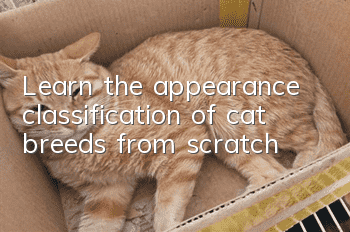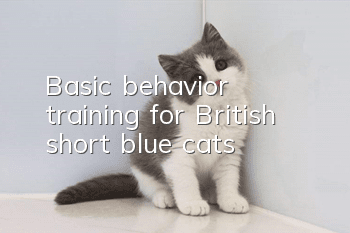Learn the appearance classification of cat breeds from scratch

Assessing a cat's condition is fun, but often difficult. Qualified breeders should master this skill so that they can continuously improve and optimize the offspring of cats they breed.
▍Why is it important to evaluate condition?
Breeders need to be able to accurately evaluate each cat so that they can establish a good breeding plan and maintain the best overall cat appearance in the cattery. Only with an accurate assessment can you decide which one to keep and which one to sell. Additionally, through an appraisal, you can explain the cat’s strengths and weaknesses to potential buyers. An objective evaluation of a cat’s appearance is a very important part of buying and selling. Of course, if you can cheat, that's a moral issue. Generally speaking, if it can be evaluated objectively, an objective price can basically be given.
▍Learning Rating
For newbies, learning how to rate kittens doesn’t happen overnight. In fact, many breeders have never learned this skill properly, and some breeders seem to be born with a good eye.
Most breeders expect to learn this skill through practical experience, but in fact they do not do anything concrete to learn it. However, there is some knowledge that if you master it now, you can maximize your existing abilities and qualitatively improve your evaluation skills.
▍Start with breed standards For breeders to learn and improve their evaluation skills, the first thing to do is to become familiar with the breed standards of the cats they breed. Once you become familiar with the breed standard, that "feel" is developed. It is recommended that you familiarize yourself with the breed standards of several associations at the same time, and also look at the award-winning cats in each competition area over the years. Although it is not possible to all be reliable, those cats are not bad either. Regarding the Chinese version of the CFA breed standard, I have translated several common breeds, such as Muppet, Persian, British Shorthair, etc. You can check the historical records to learn.
▍Develop a rating list
Create an assessment list that is as detailed as possible. Start with the breed standards and the points assigned to each section. In addition to scoring the various parts of the breed standard, you should also include those parts that you feel are most important to your breeding program. Once you have your own customized list, use it to rate each kitten on 1 to 10 characteristics. Record your review of each kitten for future reference. Add explanations where necessary as to why you gave this kitten different scores. Evaluate each litter of kittens you breed and score each item.
▍Take photos Take photos of each kitten regularly: once a month from birth to weaning, from weaning to two years old, and then to adulthood. Photos are the most intuitive. By combining the photos with the list, you can gradually see the progress of each item.
Add a photo of each cat to its evaluation report. In this way, you create a detailed record for each cat, showing the cat's entire growth process at a glance. This will help you predict the overall development of cats of the same bloodline.
▍Comparison After each photo session, go through your evaluation list and write down your new rating - and compare your new rating to the kitten's previous rating.
Are your views on kittens the same? Or have they changed over time? Do you still want to keep the cats you selected early on? Or have your thoughts changed? If your thoughts have changed, changed How much? At what age does the change occur most? Or is the change gradual and consistent?
How do your ratings in the first few months compare with your final ratings as an adult cat? How likely are you to predict a kitten's strengths and weaknesses when it reaches adulthood? Kittens from the same litter or bloodline Do cats undergo similar changes? What are the differences in the way they change?
▍Practice makes perfect The more you evaluate kittens and adult cats, the more experience you gain, the more accurate your evaluations will be, and the more accurately you will be able to predict how they will change as adults.
If possible, you can also evaluate cats from other breeders, especially those with different pedigrees than yours. This way you get a richer experience.
▍Condition grade Once you have finished evaluating the kitten, it is time to grade the kitten.
Pet level, breeding level, competition level, high competition.
Breeders usually use these four labels when discussing the appearance of cats. Each breeder's level of evaluation of cats is different, but in general, if everyone uses a type of noun to define it, it will be easier to communicate.
Although some breeders will say that their cats are all competition-level and high-level competitions, I believe that you also have the ability to judge. You don’t have to believe such nonsense.
▍Popular factors
Sometimes, a certain 'look' wins the show - this can become a trend in the appearance of cats within a breed, which can influence how different people view the same kitten differently.
For example, Persian puppets, Persians with less standard breaks, etc., may be pursued by some people. I will not comment on this, because the overall situation will not deviate from the breed standard, and the understanding of beauty and cuteness is each breeder’s own understanding. concept in mind. Moreover, the current level in China is really not bad. I believe that in a few years, the breed standards of certain varieties should be formulated under the leadership of domestic breeders.
- Will Ragdoll cats’ fur become darker in winter?
- What kind of special litter box should be prepared for pet cats?
- Why do cats eat dead leaves?
- Is it good to neuter male cats?
- Is it okay for cats to eat one kind of cat food for a long time?
- Will impure folded-eared cats get sick?
- Do cats cry after being abandoned?
- Symptoms and treatments for spontaneous cystitis in cats
- Can hair in a cat's eye come out on its own?
- How to change a timid cat?



